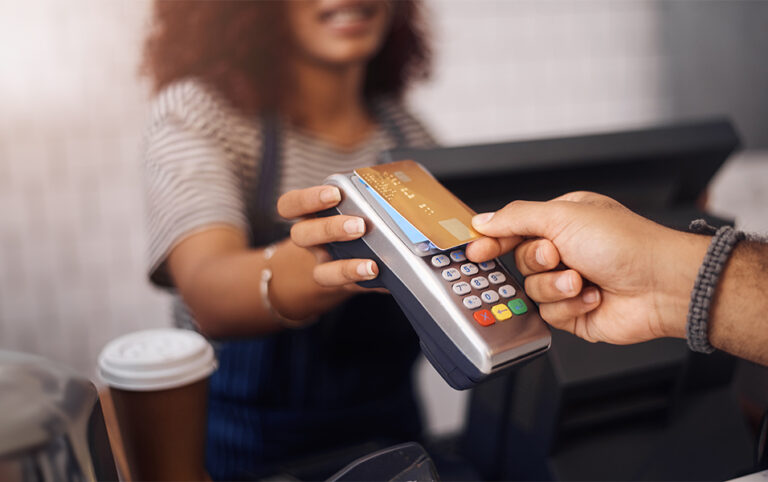When should I use a credit card?
Please rotate your device for the best experience.
Transcript
Credit Card Usage
Source: Junior Achievement USA®
Interactive Video
[A smiling woman with orange hair sitting on a brightly colored couch holding a couple of credit cards in one hand and a smartphone in the other hand.]
Narrator: Traditional credit cards play a huge role in people’s financial life—maybe too large a role for some. About 83 percent of people in the United States have at least one credit card, and about 40 percent use them for daily purchases.
[A pie chart showing 83 percent representing the people in the United States who have at least 1 credit card and 40% for those people who use their credit cards daily.]
All that credit adds up. According to Lending Tree, at the end of 2022, total U.S. credit card debt had reached $986 billion.
[An illustrated credit card centered in an outline of the United States.]
And traditional credit cards have some of the highest consumer interest rates. But don’t get confused; that’s interest you pay on top of your balance if you don’t pay off your balance each month, not interest you earn. Paying with credit cards can be costly, so choose carefully when to tap or swipe.
[A woman holding a credit card and looking at her phone with a shocked expression on her face. On screen text: “That’s high interest!”. Equation: interest + balance = what you pay. A hand appears holding a credit card in front of a credit card machine. A caution sign appears.]
Good money managers think beyond the choice to grab cash or the credit card when they pay. Because there are several payment choices, it’s important to have a game plan on how to pay for things and to know the consequences of those choices.
[A man sitting at a kitchen table typing on a laptop. He has a calculator in front of him with several papers spread out under the calculator. An illustrated chart of icons representing a financial game plan.]
Take a moment to reflect on how these different payment options might affect your money situation. Look at it through the lens of good money management. Select what you think is the biggest positive and biggest negative money impact when using each payment type.
[A table with three headings: Payment Option, Positive Impact, Negative Impact].
Cash positive options:
- can’t spend beyond what you have
- as soon as you buy something you own it
Cash negative options:
- can’t buy things online
- no protection if lost or stolen
Debit card positive options:
- easy to track spending
- convenient for daily purchases
Debit card negative options:
- limited fraud protection
- easy for online shopping
Credit card positive options:
- can pay later
- builds credit history
Credit card negative options:
- difficult to dispute fraud
- pay high interest on balance
Results
Using credit wisely, means that:
- You shouldn’t spend beyond what you have.
- You keep balances low or paid in full.
- Credit helps build a positive credit history if used responsibly.
- Credit is a great option when you need fraud protection such as online shopping or international travel.
Credit cards can play an important role in your personal finances if they are handled correctly. Good money management is all about keeping debt low or nonexistent. So, first and foremost, credit is OK if you pay it off each month.
[A person holding several credit cards. On screen text: keep debt low or non-existent; credit is OK if you pay it off each month.]
They are also excellent resources to build your credit. And like it or not, credit reports play an important role in decisions in today’s society. If you think of credit as more of a future-building tool vs. another way to pay for things, you’ve got a great financial strategy.
[ A credit report on a clipboard showing a score of 745. Listed below are two statements with check marks beside them: on-time payment, payment received in full.]
Credit cards are a smart choice for:
[Flash card carousel]
Card 1
online shopping (to protect your financial data)
[A woman shopping for clothing on her smartphone.]
Narrator: Credit cards are a smart choice for: online shopping, to protect your financial data.
Card 2
Build a positive credit history. Credit cards demonstrate an on-time payment history and adds a mix of credit types to your report.
[A person using a credit card to make an online purchase on a laptop.]
Narrator: building a positive credit history (by demonstrating an on-time payment history and adding a mix of credit types to your report)
{Card 3}
Emergency Situations. Credit cards help when you need a last resort back-up plan, after savings, to pay for something unexpected.
[A woman talking on the phone while plugging a leak under the sink.]
Narrator: emergency situations (when you need a last resort back-up plan, after savings, to pay for something unexpected).
Narrator: Using a credit card is a convenience and a benefit if used wisely. Swiping or tapping is easy and charges add up quickly.
[A smiling woman paying for a flower plant using the tap-to-pay feature on her credit card.]
Narrator: If you get a new credit card because you already maxed out one, consider that a red flag.
[Animation of receiving a credit card in the mail. A warning flag appears on the left side of the screen.]
Narrator: Ask yourself: Can I pay off the balance in full this month? If you can’t, consider leaving your credit card in your wallet.
[A smiling woman sitting on a brightly colored couch holding a couple of credit cards in one hand and a smartphone in the other hand. A thought bubble appears next to her head that reads “Can I pay off the balance in full this month?”]
